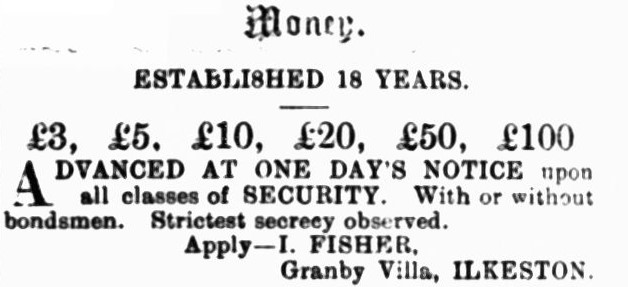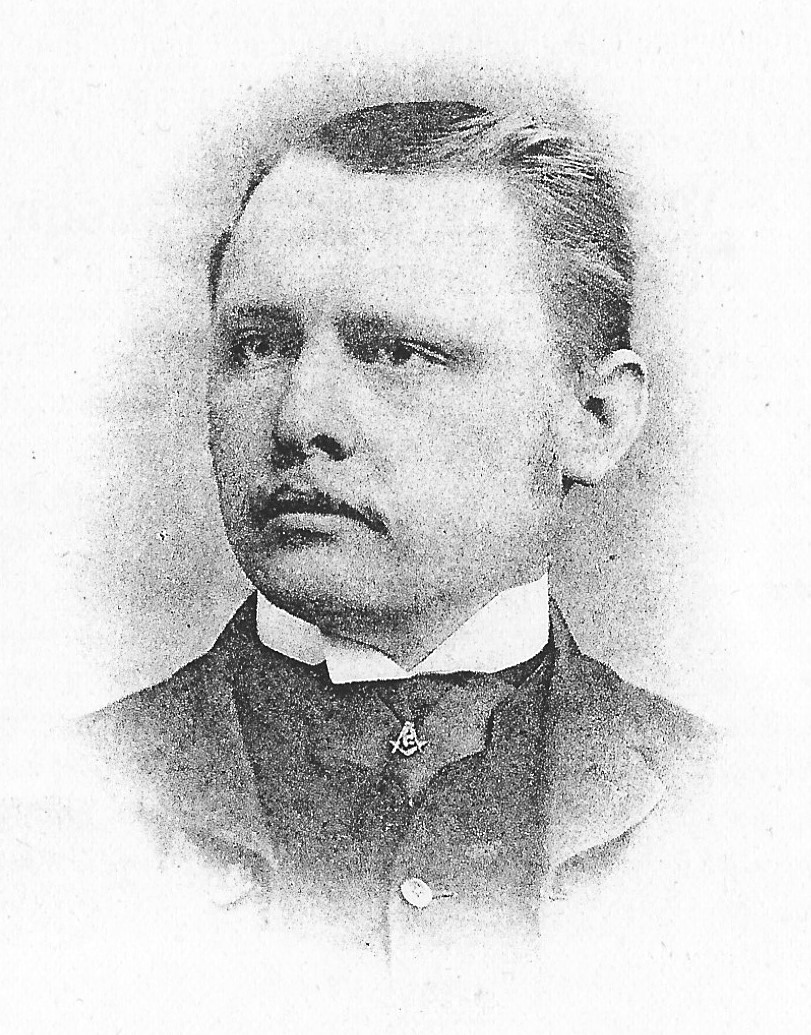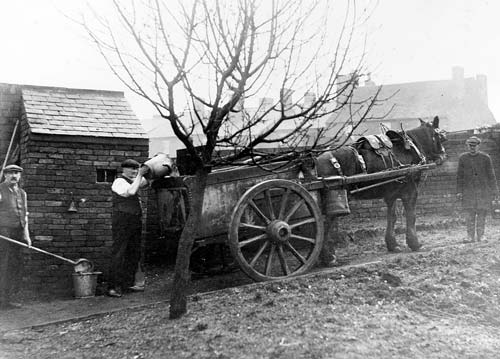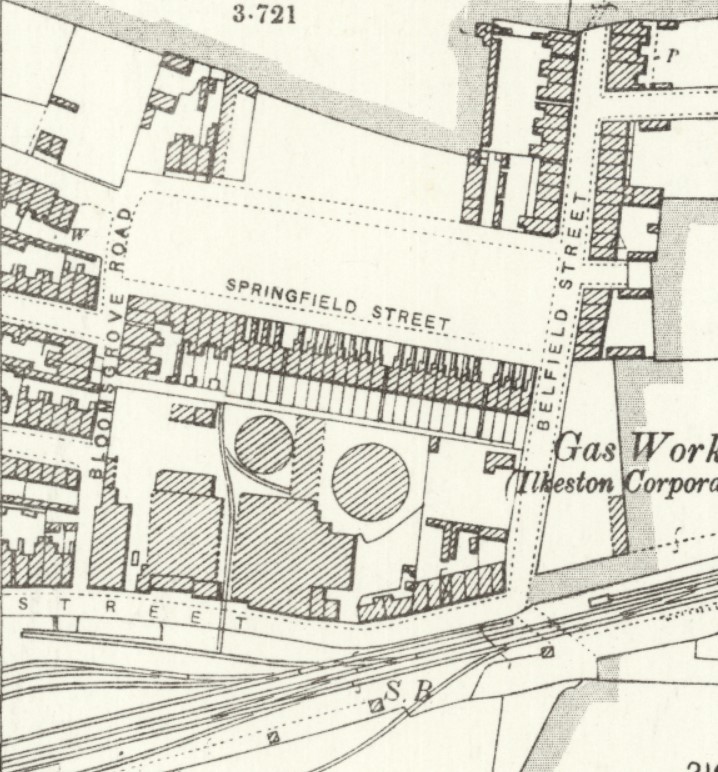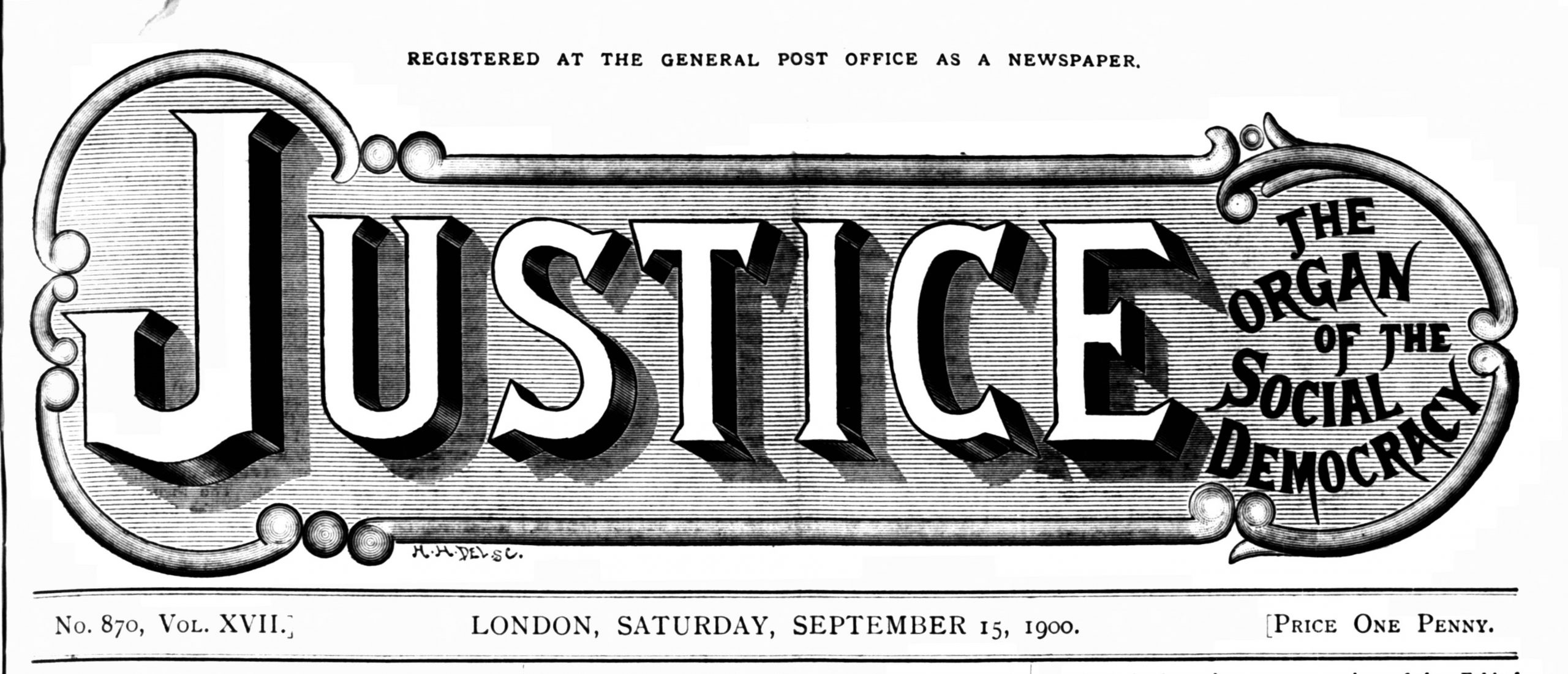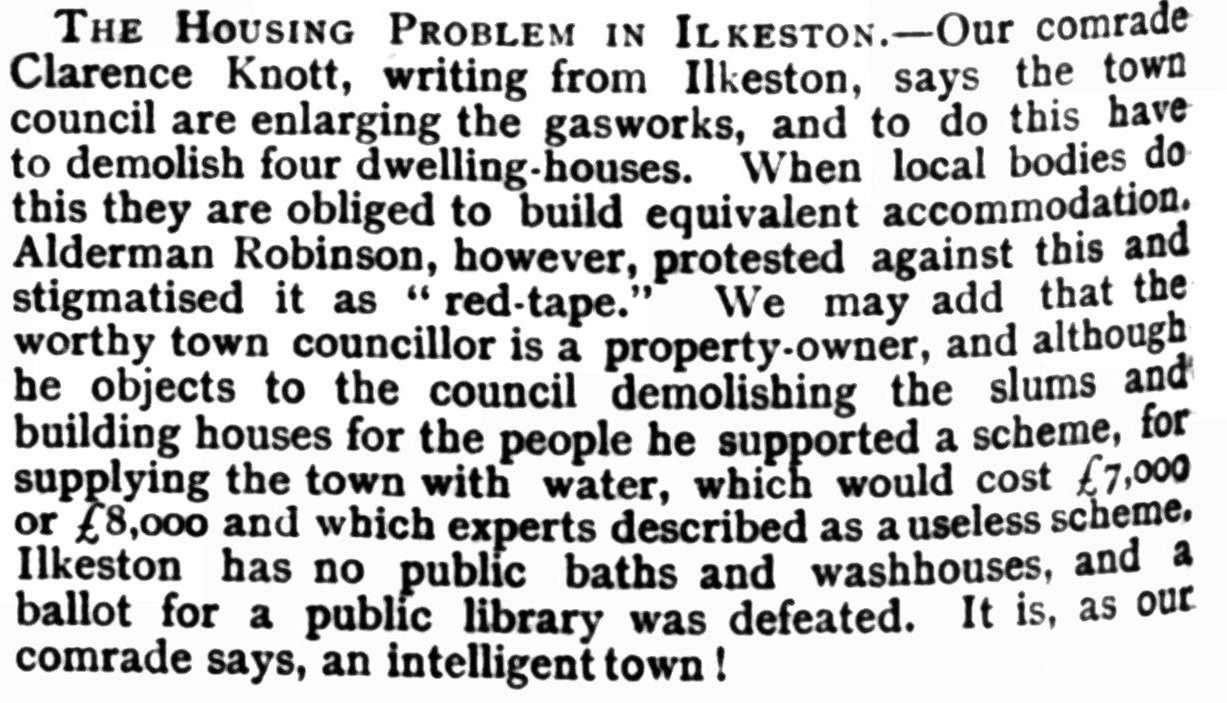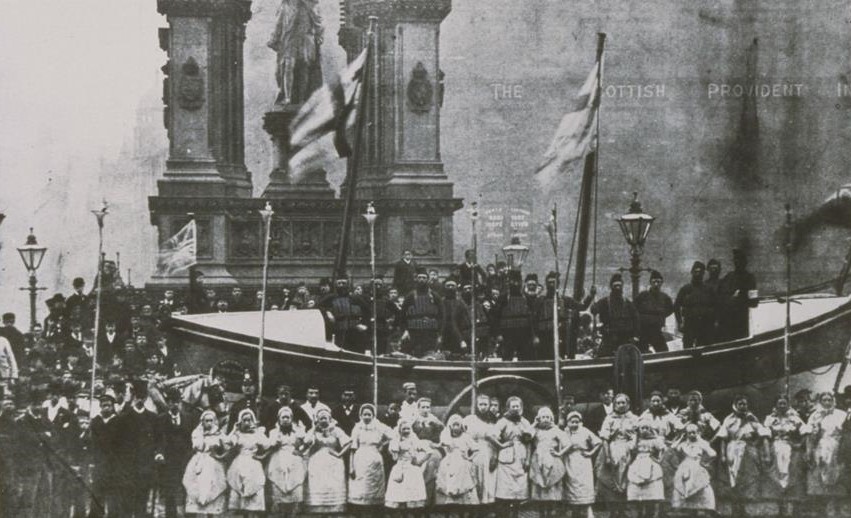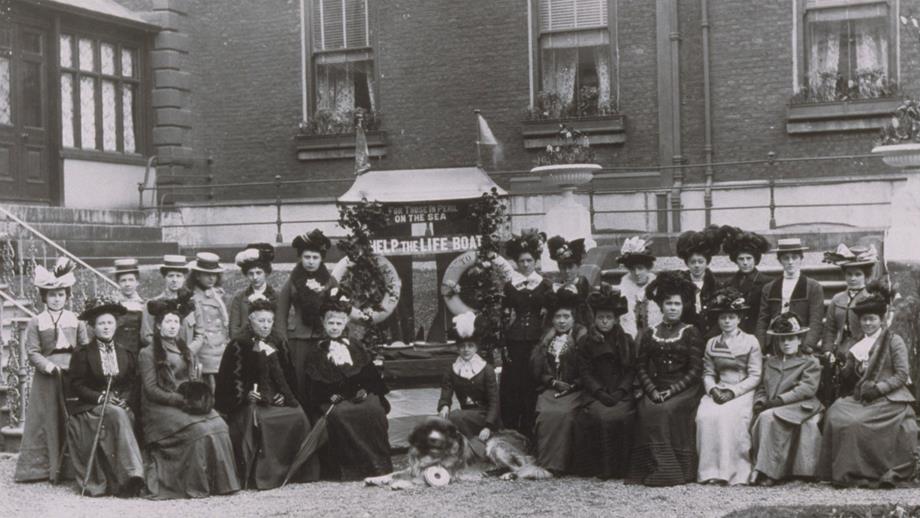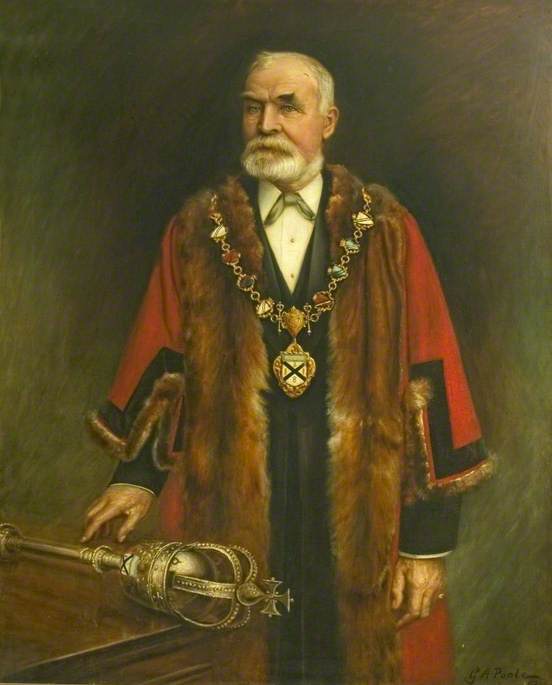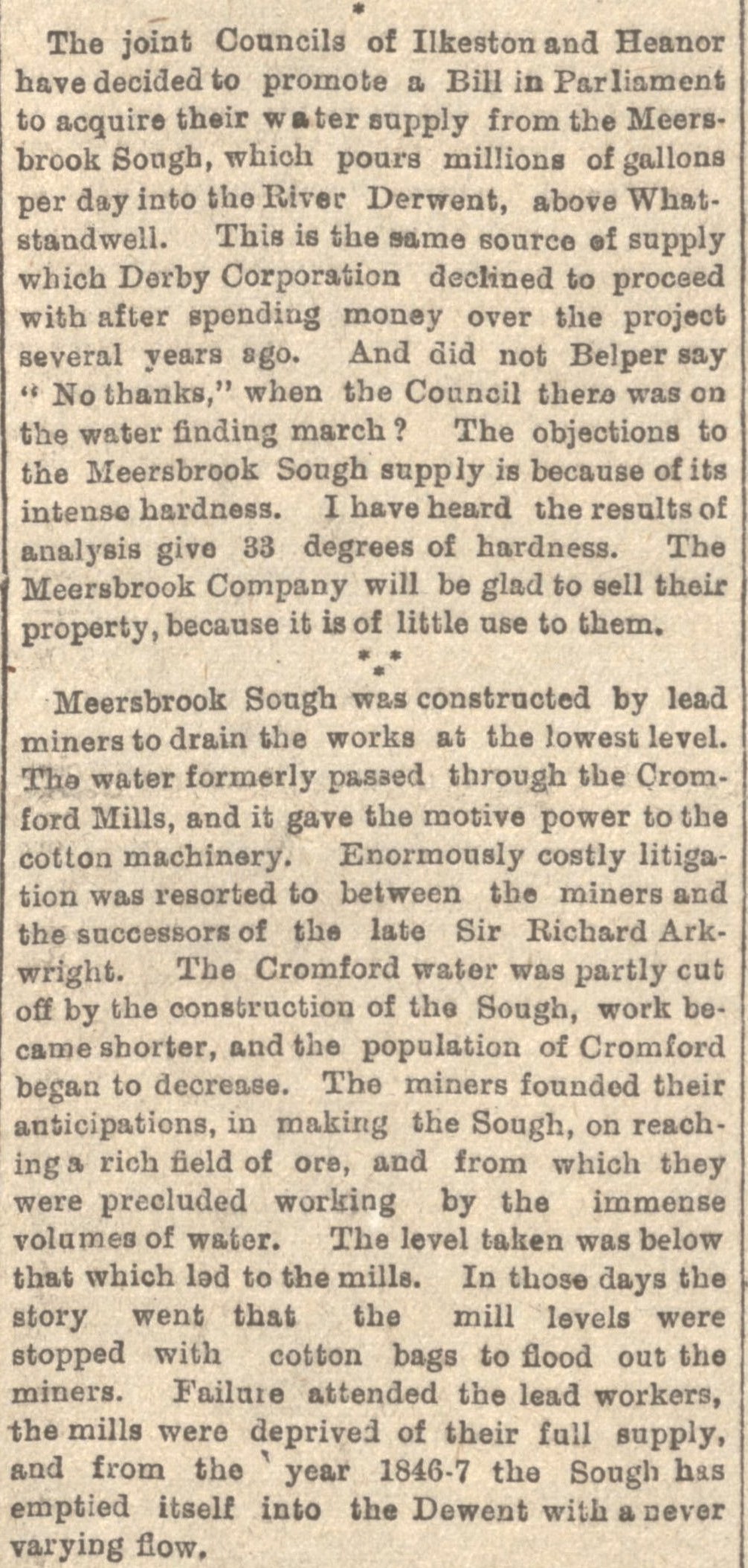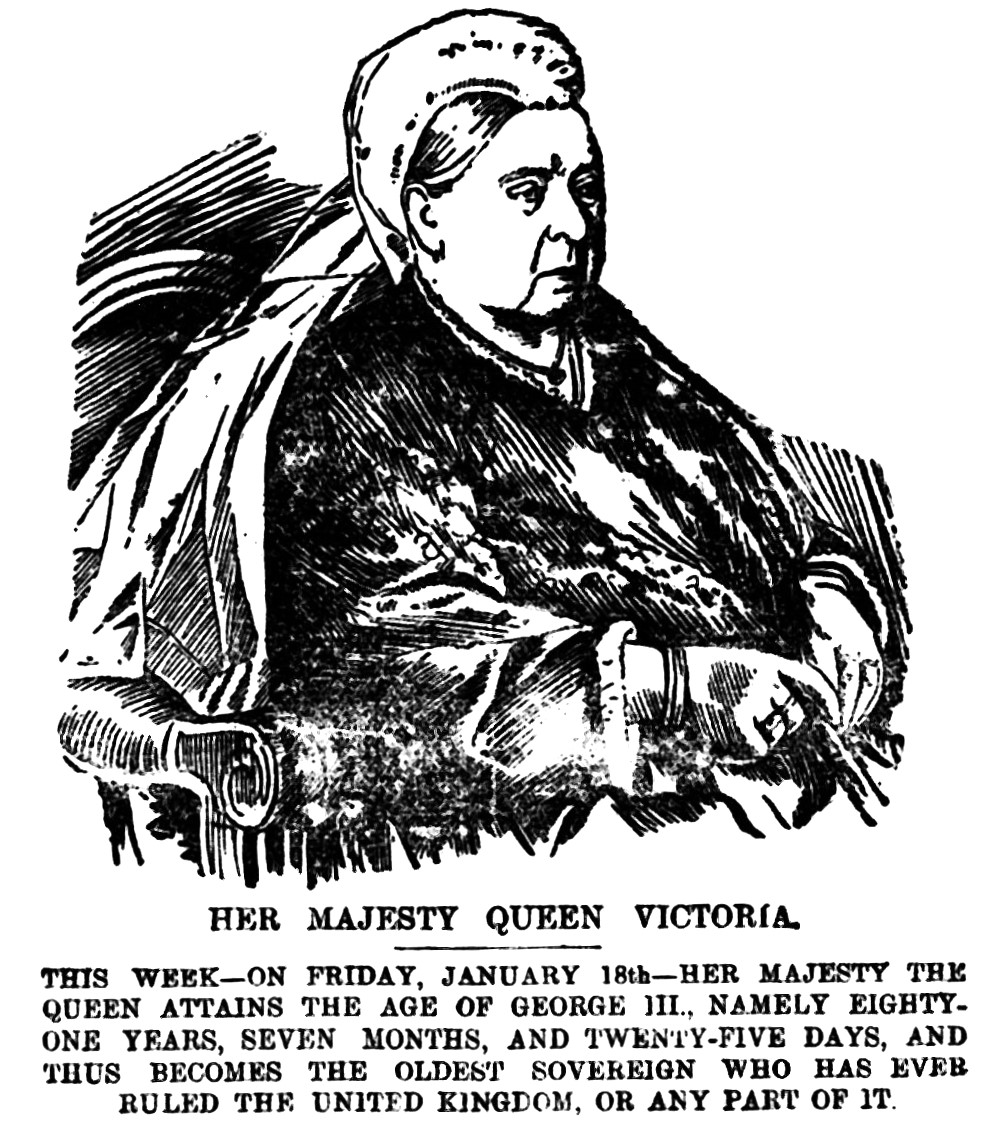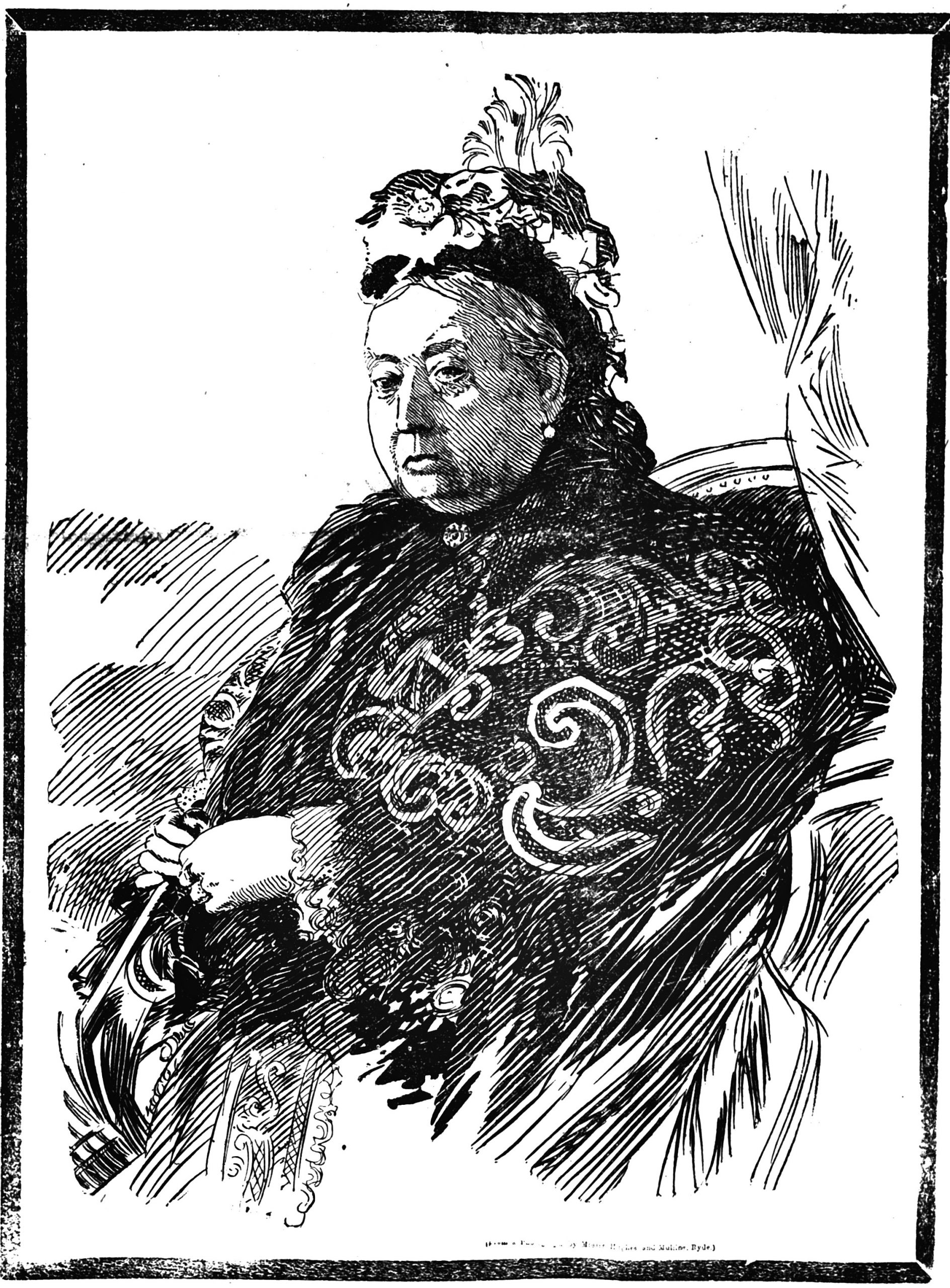From Continuing Issues we move on, arriving finally at …
1898
January 1898: Town improvements shelved ?
Two schemes were being discussed.
It had been suggested that the Gallows Inn bridge be altered and widened, and that the cost of the work be equally shared by Ilkeston Council, Derbyshire County Council and Nottinghamshire County Council. Both the first two bodies agreed to the proposed deal but as the Notts C.C. was not prepared to stump up its share the scheme was put ‘on hold’ … in other words it was referred to the Council’s General Works Committee.
It was put ‘on hold’ until June 1900 !! (In fairness it was discussed on several occasions in the meantime) and then the Council agreed to pay £250 towards the widening while N.C.C. were to pay £300 and the D.C.C. would pay £733. In the event, a couple of months later, the Council finally agreed to pay £300 whiule the County Council would do all the required work.
The second issue was addressed by Messrs Derbyshire Bros. of Nottingham who expressed their continued willingness to provide a tramway for Ilkeston, a willingness the firm had been voicing since 1895 . They warned that the initial capital expenditure would be so substantial that investors would have to wait several years to enjoy a return for their investment. A Bill in Parliament was needed, the proposed route being from Cotmanhay to Hallam Fields. This too was referred to the General Works Committee.
February 1898: has the Council finally seen the back of Joseph Carroll ?
On February 2nd the Nottingham Journal described Joseph Carroll as, “for the past ten years, the Medical Officer of Health for the Borough of Ilkeston“, obviously oblivious to the fact that he had been removed from that position in the summer of 1894 — since which time the Council had had the time to appoint two other MOHs. The Journal was correct however when it went on to report that Joseph had lectured on sanitary subjects for the Derbyshire County Council and had been a member of the County Health Committee for some years. Now he and his family were leaving the area as he had been appointed lecturer on hygiene and public health at Anderson’s College Medical School in Glasgow, replacing the late Dr. J Pearson Munro.
Dr. Carroll was replaced in the Southern Division of the County Council by Edwin Trueman who was returned uncontested at the election. However, in the Northern Division of the County Council, at the same time, there was a contest — between Councillor Isaiah Fisher and Dr. James George Willis, Ilkeston’s Medical Officer of Health. The former was victorious with a majority of two votes !! — 747 vs 745.
Isaiah was elated by this result and after a County Council meeting at Derby he returned to Ilkeston to celebrate with his friends at the Great Northern Inn on Cotmanhay Road. Now, Isaiah seems to have been a man who could remember a ‘wrong’ and hold a grudge very well; he remembered that George Hart, a grocer and colliery contractor who lived close by in Norman Street, had refused to sign Isaiah’s nomination paper just before the election and the newly-elected County Councillor couldn’t forgive or forget this. During the drinking party he told his friends a salacious story about George’s wife Ann (nee Brentnall) behaving ‘inappropriately’ with her ‘chap’ Wheatley Bostock, before her marriage to George (in 1864), in a passageway next to the South Street chapel which the couple were visiting; the purpose of the visit was to hear a sermon or speech by “Fiddler Joss”. Isaiah’s pub story was overheard by Ann’s brother John, and it was a story which soon after landed the teller in the Nisi Prius Court at Derby Assizes, defending a charge of slander. Ann denied the story completely, stating that she had been married 35 years and had raised 6 or 7 children (I can count only 5 !!), and that the esteem and respect of her neighbours had been severely damaged by this foul, most cruel and absolutely unjust slander. Wheatley Bostock, now living in Basford, was called to give evidence and stated that for more than two years before her marriage, he had ‘kept company‘ with Ann and had often ‘misconducted himself‘ with her. Other witnesses were called to refute the story and it was pointed out that the Ilkeston visit of ‘Fiddler Joss’ was several years after Ann’s marriage. No settlement could be reached between the accused and accuser and so it was left to the jury to decide. Isaiah was fined £300 pounds damages for his uncontrollable mouth.
P.S. The story of “Fiddler Joss’s ” visit to Ilkeston is told elsewhere and it was true, as Ann stated, that it occurred after her marriage. She also stated that her relationship with Wheatley Bostock was far shorter than ‘over two years’ and that she stopped it when she discovered “what sort of man Wheatley was “!! There were several men with that name born in Victorian Ilkeston — this one was born on August 28th, 1834, the son of John and Hannah (nee Straw).
The hefty dose of damages which Isaiah now had to pay didn’t interrupt his onging ‘trade’ ….
The Ripley and Heanor News (Ilkeston Division) March 1899
February 1898: has the ‘proper time’ to introduce electric light finally arrived ? … by June it had !!
A special Council meeting was called to discuss the provisions of the Government’s General Power Distributing Act 1898 … not very exciting you might imagine. However one of its proposals was to generate and supply electrical energy within a large area, including the borough of Ilkeston.
A few days before this meeting, a conference of the authorities within this area had discussed the Bill and passed a resolution opposing it, recommending that all the local authotities should do likewise. At the special meeting the Town Clerk, Wright Lissett, explained the bill and how it would be prejudicial to the best interests of the Ilkeston Corporation. It was decided unanimously to oppose the bill. In fact, in March 1899, this bill was defeated on its second reading in Parliament and the Nottingham Corporation was very active in securing this defeat.
The ‘lighting issue’ (or ‘Power Issue’ .. or whatever you might want to call it) had always been a contentious subject and a source of much conflict within the lives of the Highway Board and then the Local Board before the Town Council had to grapple with it. In 1892 the latter body had sought a report on the question of electric lighting from Frederick Chilton Humphreys, the Gas manager (!!), the result being that the introduction of any Electric Lighting would be delayed until the ‘proper time’ arrived … and the Town Council would be the body to decide when that time was, and how to introduce it !! Then the subject of the town’s tram car arose, with Messrs. Derbyshire Bros. (above) expressing an interest to supply that service; this meant that the Council had perhaps to grapple more seriously with ‘electricity’.
But for the time being it was ‘put on hold’ … though not for much longer. A few days later the General Works Committee had deliberated and decided that a public promotion of tramways for the borough was preferable to a private company providing the service
And so, in June 1898, the Council unanimously decided to apply to the Board of Trade for provisional orders for the authorising of two schemes of tramways (under the Tramways Act 1870) and electric lighting (under the Electric Lighting Acts 1882 and 1888) in Ilkeston. The fact that the decision was unanimous was due to the work of the Town Clerk, Wright Lissett, who had produced a report on the overhead electric trolley system at Dover which had proved such a financial success that the council there had been able to reduced the rates by 2d in the pound, using the profits of the scheme. The Council members were seduced by the thoughts of a similar windfall for Ilkeston !!
It should be noted that Tramways Act did not give a local authority the power to operate a tramway on its own account but gave it the power to lease it to other people. However the resolution, unanimously passed in June, sought to go further and authorise the Council to operate the tramway for passengers and other purposes, and to collect fares for doing so.
To demonstrate how seriously the Council was considering the introduction of these schemes, in August 1898 a Tramways and Electric Lighting Committee of 11 members was formed. And this new committee was soon flexing its muscles !! In September of 1898 it was agreed by the School Board that a spare piece of land at the side of Gladstone schools be sold to the committee for an electric power station to be built there — so long as a 12 foot-wide road on its east side be made and maintained by the Council. It was also decided that the tramways should be of a guage of 3ft 6ins and that no engine or carriage be wider than 6ft. Compared with systems in other parts of the country, this was a rather restricted gauge but perhaps the topograhy of Bath Street determined its choice: it was too narrow to accomodate anything wider ? And in October 1898 the Council agreed that electric cable for lighting purposes should be laid only to Bath Street, the Market Place and Market Street — other streets could be added to this list when there was a demand from private consumers.
And of course, with any new scheme, there was opposition. One ‘natural’ opponent, to both trams and electric power for the town, was the Great Northern Railway Company, though its opposition lasted only until early 1899 when it was withdrawn. Final approval for the provision of electricity for lighting and other services was given in June 1899.
Almost a year later, in May 1900, the Inspector for the Local Goavernment Board arrived in town to consider the Council’s request to borrow £18,271 to provide electric lighting for the town. The generating station would cost about £28,452, and was planned to have a refuse destructor, erected near the station, which would greatly reduce costs of production. The loan sum sum would be divided equally between the tramways and electric lighting schemes. The rest of the loan would pay for the laying of the mains, wires, etc.
What about the tramways ?? (see below)
April 1898: a couple of letters to discuss
The Charity Commission had written to the Board about the Roe (Rowe) Charity and the letter was discussed at the monthly meeting. As stated by the conditions of this charity, one-sixth of the annual income was regarded as ‘ecclesiastical’ and was paid “for the benefit of the minister of the Protestant Dissenters at Ilkesto“; the remainder of the income was ‘non-ecclesiastical’. At this time the charity assets were one field at Eastwood which brought in an income of £13 p.a.
When the charity had been set up there was only one Protestant Dissenting minister in Ilkeston and that was the Presbyterian (later the Unitarian) minister, who had always been the recipient of the charity. The meeting resolved to add words to the Charity conditions and so make this recipient explicitly clear.
Aldermen Francis Sudbury and William Tatham were appointed trustees of the non-ecclesiastical charity.
At the same meeting it appeared that Park Cemetery was still proving to be a contentious issue between the Council and the town’s vicar. The latter had just written yet another letter indicating that, from now on, the clergy would no longer attend Sunday funerals at the publc cemetery and asking that Sunday funerals be discontinued. The request was promptly declined and Councillor Edwin Trueman, himself a Churchman, applauded and supported this decision, arguing that the clergy should carefully consider the interests of the ‘working classes’ for whom Sunday was the most convenient day.
September 1898: the ongoing problem of Ilkeston’s water supply
As noted in the previous page, the Ilkeston Corporation Bill had received Royal assent in July 1898. This now allowed the Council to borrow funds for its several schemes, one of which was to provide new machinery and infrastructure for an improved water supply. As part of the arrangement the Council had agreed to sink a trial shaft at Little Hallam to a maximum depth of 150 yards. By September only 50 yards had been achieved and it was thought necessary to order a larger pumping engine, twice as powerful as the existing one.
October/November 1898: election time once more … and the knives are out !!!
The Council elections of November 1st were approaching and following custom two members from each of the three Ilkeston wards had to resign their positions, although all were seeking re-election. One of those councillors, in the North Ward, was Richard Hunt, lace manufacturer of Cotmanhay Road. On October 11th — and getting in early — he appeared at a public meeting of Liberals at the Wesley Street schoolrooms where he extolled his own virtues displayed over the recent months. He reminded his audience that he had warned of an inadequate water supply at Little Hallam where the recent boring had been made; he was instrumental in enabling the Health Committee to admit working-class patients into the Sanatorium and defray the cost of their maintenance: and he had moved a resolution that the Town Council rather than a private company should undertake the town’s tramway scheme itself and so reap the profits. All were evidence that he was, once more, a worthy candidate, and the meeting unanimously agreed. As it turned out, this was the only ward in which a contest was not needed !! — the other candidate to be elected was Joseph Kirk of the Derby Arms beerhouse in Cotmanhay Road.
Although ostensibly the elections in the two contested Central and South Wards were not run on ‘Party lines‘ each candidate clearly had political leanings. In the Central Ward Samuel Wood and Frederick Sinfield (Slow and Sure — Vote for Sinfield) were the Liberals, Thomas Henry Richardson was the Conservative while Benjamin Gregory had strong Trade Union support and stood as a Labour candidate. In the South Ward Charles Mitchell (Liberal) and Edwin Tinsley (Conservative) were the retiring councillors but were joined by John Hancock (Liberal) and labourer William Smith, dubbed by some as “the farcical candidate” with no chance at the election.
Samuel Wood and Thomas Richardson were elected in the Central Ward; Frederick Tinsley and Charles Mitchell were returned in the South Ward. (William Smith polled 18 votes).
Shortly after this, at the accompanying “Aldermanic Elections” when only the Corporation Board members had the vote, Councillor Charles Maltby of the Central Ward was elected onto the ‘Aldermanic Bench’, taking the place of William Tatham, who was thus unceremoniously ejected from the Bench, much to his annoyance.. This choice created a good deal of rancour and bitterness within the governing body of Ilkeston. The ousted Alderman Tatham certainly didn’t want to give up his position as alderman; he felt that his past 24 years of public service for the town would ensure his re-election and he had been promised the necessary support. But he had seriously miscalculated and had been misled. His removal was “one of the darkest, most despicable and mean-spirited acts” in the local government history of Ilkeston, according to some of William’s Liberal friends. It was claimed that underhand tactics and vested interests (Tories of course, but with the aid of two ‘disloyal Liberals‘) were at play to secure William’s removal and replace him with Charles, a Conservative. Obvious tensions within the small body of Ilkeston’s governing elite were simmering and were about to surface.
Because Charles Maltby had been a Town Councillor there was now a need for a byelection in his Central Ward to elect someone to replace him. Step forward Thomas Roe (Liberal and Non-conformist), printer and stationer of Bath Street, and Benjamin Gregory (Independent), coal dealer and political agent, to contest the seat.
A public meeting of Liberals and Non-conformists was arranged at the Town Hall, where the candidature of Thomas Roe could be adopted — and who should be chairman at this gathering but none other than William Tatham? This was a perfect opportunity for him to “let off steam and vent his spleen” … and he did just that, referring to his ousting by ‘a unique gang of conspirators styling themselves ‘Independent’ Town Councillors‘. With sarcasm dripping freely from his lips he turned to the ‘unique‘ councillor who had replaced him “in the best interest of the town” (much laughter here) — an ex-mayor and J.P. Councillor Maltby was “such a beloved townsman, with all the glamour of his Scotch estates hanging about him” (more laughter). William’s complaints were followed by friendly speakers who echoed his resentment, and it was clear, from what was said, who were the ‘guilty parties’ — though of course, it had long been clear who they were. Singled out as the villains, Councillors Horace Moss and Edwin Trueman were so incensed that they felt the need to rise and defend themselves, denying that neither of them was ‘guilty’ of the accusations levelled against them. Shouts of ‘liar‘ and ‘deliberate lies’ were heard, and once more the claim was uttered that this was one of the shabbiest actions ever perpetrated in Ilkeston.
However, the meeting hadn’t been called to simply listen to ex-alderman Tatham’s moans — it had other business to consider. Thomas Roe had to be confirmed as the official Liberal candidate in the byelection, and many were prepared to speak in his favour. His candidature as an openly avowed Liberal and Non-conformist was thus confirmed and many of his supporters were confident that Thomas would win. His opponent Benjamin Gregory had, until a short time previous, been a Radical Liberal but now came out as a Labour candidate and a formidable ‘contestant’, so much so that others were predicting a very close contest. If local Conservatives could be persuaded to vote for him rather than sitting on their hands, then Benjamin could conceivably win. And indeed, the vote was very close — Benjamin polled 548 votes and Thomas 525. Thus Benjamin Gregory who had lost his position as Town Councillor on November 1st was now, on November 30th, once more a Councillor.
P.S. When local elections approached it was often that candidates — particularly Conservatives — chose to fight the election as “Independents” and not under any “party colours”. One reason was that they felt it would enhance their chance of success.
Of course, as it was now November, it was also time to nominate a new Mayor. Alderman Samuel Robinson of the Old Harrow Inn was in line for that honour, but this selection certainly didn’t go down well with some members of the community. And all of them were ready to voice their concerns at a public meeting, called by the Non-Conformist Council, in the Town Hall on November 6th. Several leaders of the Non-Conformist chapels in Ilkeston were there, standing alongside and supporting Councillor Joseph Scattergood. Chairman at the meeting, Mr. J. Briggs, expressed his regret that the moral tone of the Town Council was so low as to think that his audience would tolerate a man engaged in the business of a publican to preside over their local affairs — in other words, engaged in a trade that was the most active and constant cause of crime, of pauperism and of demoralisation (loud applause and hisses at this point — also at this point William Holmes, landlord of the Sir John Warren, protested at the citing of Samuel’s name but he was shouted down temporarily). A resolution was proposed to the meeting by the Rev. Spivey of the United Methodist Free Church imploring the Council to reject a publican as the town’s next mayor — it would be like putting the Mayoral chain around a beer barrel and glorifying it (more applause).
The landlord of the Sir John Warren once more demanded a voice and from the platform, suggesting an amendment proposing that Alderman Robinson was a fit and proper person to represent them as Mayor. His allotted speaking time of ten minutes (constantly interrupted by jeers and boos) was soon up however and he was requested to sit down. His refuasl prompted a confrontation with Councillor Scattergood who wisely retreated when he could see that William ‘meant business’. Unfortunately for the latter no-one would second his motion and eventually the meeting passed (unanimously and to loud applause — William Holmes must have left bt that time !!) a resolution regretting the choice of Samuel Robinson as the next mayor because of his occupation. However it was too late !! — at a private meeting of the Council Samuel had already been chosen as Mayor Elect (though not unopposed — principled Joseph Scattergood was the sole voice against, preferring his ‘candidate’ Councillor Charles Mitchell, who remained neutral)) and Samuel’s election was confirmed on November 9th. The following Mayoral Divine Service took place at the Parish Church on November 12th.
Samuel Robinson (November 24th 1855 – March 30th 1911)
The Ilkeston Corporation was now also looking for a new auditor when Joseph Stirland, the present one, was found guilty at Derby Assizes on December 1st, of forgery with intent to defraud — (he was also charged with embezzlement but this wasn’t pursued) — and was sentenced to nine calendar months in jail with hard labour. As a result the Shipley and Cotmanhay Floral and Horticultural Society was also looking for a new secretary to replace Joseph. The judge at the case bemoaned the fact that changes in the law had meant that these offences were now treated much more mercifully.
After a byelection, a vote of ratepayers (those who could raise the interest to get to the Town Hall Polling Station) appointed Arthur Pitt, an accountant of Burr Lane, as the new auditor in January 1899. However Arthur didn’t last long. The byelection was followed on March 1st by the annual election when Arthur came third among four candidates (the top two being appointed as auditors — so Arthur just missed out !)
——————————————————————————————————————
1899
January 1899: the death of a Council worker
Labourer Charles Shelton, aged 31, lived in Awsworth Road and was employed by the Council as a ‘nightsoilman’, an occupation which his father had also been engaged in; he had been doing that job for about 18 months.
On the night of November 1st/2nd of the previous year William Adkin, a workmate of Charles, was travelling along Skeavington’s Lane, Cotmanhay, with a load in his wagon, when he came across Charles lying in the road, seriously injured, with his cart and horse some way away from him. Charles was able to tell his mate that both his legs and one arm were broken — he had tried to spur his horse to go faster, had lost balance and had fallen from the shafts of his cart, then getting caught under its wheels, and being dragged some distance before he became free. There was no-one else to blame but himself he explained, William wrapped horse rugs around his injured pal, went for assistance and then managed to transport Charles to Ilkeston hospital.
Despite an operation and the efforts of the hospital staff, Charles couldn’t survive his injuries and died on January 3rd 1899. The inquest returned a verdict of ‘Accidental death’, the jury adding an expression of its disapproval of the practice of riding on the shafts of the cart.
March 1899: Public Baths and Gas expansion get the go-ahead
In support of a motion introduced by Councillor Joseph Scattergood, the Council voted unanimously to select a site and prepare plans and drawings to provide public baths for the town. Joseph favoured the old waterworks site at the end of Queen Street though a site in Bath Street was also suggested. All very reminiscent of talks which had begun as long ago as 1887 !!
At the same meeting the Council also provisionally passed a motion to buy land and houses at the rear of the Rutland Street Gas Works, subject to the approval of the Local Government Board (i.e. approval to the purchase and to the raising of a loan to pay for it, and for any improvements needed).
This land and property (right) had previously been owned by the late Samuel Whitehead and George Swanwick, a total of 34 dwelling houses and adjoining land, on the north side of the Works (known as Springfield Street, though the houses were sometimes referred to as Springfield Terrace)
This area was thus bounded on the east by Belfield Street, on the north by Barker Gate, and on the west by Lower Bloomsgrove Road.
This plan and the loan of £4000 needed for it were finally discussed at a Public Enquiry in March 1900.
At the Enquiry in 1900, it was noted that in March 1882 the Gas Works supplied 26 million cubic feet of gas to 617 customers and 134 street lamps. Now, in 1900, it supplied over 70 million cubic feet to 2200 customers and 382 street lamps. In the last year alone, an extra 7 million cubic feet had been supplied, and demand was almost certain to increase by the same amount in future years. New purifiers, an additional washer, extra storage capacity for coke and coal, additional railway sidings, a new meter and exhauster — all were needed according to Town Clerk Wright Lissett. The land adjoining the present works was ideal for such expansion, at an estimated cost of £4400. (This included the cost of enfranchisement of one portion of the property which at present was copyhold)
Some in the town were not pleased by the attitude of some Council members over this issue ..
Mentioned in the article, Alderman Robinson was the ex-mayor Samuel (above): the ‘useless’ water scheme referred to was the on-going boring project at Little Hallam, which had cost so much yet had produced so little.
April 1899: proposed Bath Street improvements and a new loo
The Council was facing a Local Government Board Inquiry at the Town Hall after it had put in a request to borrow yet more money — £4630 for improvements to Bath Street. In more detail ….
… £3730 was requested to widen Bath Street around number 155, approximately opposite Brussels Terrace, by taking away a portion of the pavement. The total included £2775 to purchase the property, £565 to then alter the premises, and £350 to alter the buildings at the rear and make the property complete once more. Other incidental expenses would make up the total. The premises which had already been bought projected a considerable distance beyond the buildings on either side. They had been built about 30 years before, at a time when there were no other buildings there. Since then, other premises had been built, standing back from the original ones, and so a new building line had been established. The ‘old’ buildings were now out of place. It was becoming a very busy part of town — there were two railway stations, a theatre, a bicycle track and a football ground nearby — so that the pavement and street both became congested at these times.
…. £900 for improvements to the same street but at the Market Place end.
In addition, £450 for the construction of “an underground sanitary convenience” in the Market Place, in place of ‘the present unsightly erection‘.
A couple of months later the local press was reporting that a loan of £880 had been sanctioned by the Local Government Board for street improvements at the Harrow Inn corner, and a second loan of £475 for the construction of a sanitary convenience in the Market Place.
June 17th 1899: the Lifeboat Saturday Movement comes to town
There was nothing the folk of Ilkeston liked more than a procession, or so it seemed. (except perhaps for Committees ?!)
So here we have a procession coupled with yet more Committees !!!
The Mayor was on hand at a Public Meeting at the Town Hall on April 17th, when it was decided that the Lifeboat Saturday Movement be received and adopted in the town.
This Movement had originated in Manchester in 1891 when a local industrialist Charles Macara organised the first Lifeboat Saturday. This was in response to the “Mexico Disaster” when, five years before, 27 members of a lifeboat crew from Southport lost their lives trying to rescue crew members of the stricken vessel ‘Mexico’. Charles had been touched by the plight of the widows and children of the drowned volunteers. He organised a collection for them but rather than asking his wealthy friends for donations, he appealed to the person in the street — the world’s first charity street collection ever recorded, and a trend which continued for decades. The funds collected were to be used to pay grants to widows and children of lifeboat members who had lost their lives in service; to compensate those who had been injured in service; to fund service awards, and pension or retirement allowances to some lifeboat officers.
The world’s first street collection for the RNLI, in Manchester, 1891.
Lifeboat Saturday catches on – Lifeboat Day with the Dublin Ladies’ Guild in 1901
And now it was to be continued in Ilkeston in 1899. The first full-blown Ilkeston lifeboat demonstration was on Saturday, June 17th, and to ensure the smooth operation of the event, Ilkeston was now blessed with a “Demonstration Committee”, a “Friendly and Trade Societies’ Committee”, a “Finance Committee” and a “Ladies’ Auxiliary Committee”.
Practically all the town’s tradesmen invested in the occasion, raising numerous flags, with streamers strung across Bath Street. The resultant procession, over a mile and a half long, consisted of about 50 or 60 features, in the shape of public bodies, friendly societies, brass bands, fire brigades, Sunday schools, trade carts, etc.. It started at the Market Place in the afternoon, at a quarter to three, travelled along South Street, Stanton Road, Regent Street, Nottingham Road, Market Street, Bath Street, Granby Street, Cotmanhay Road, Church Street, to Shipley Lodge entrance where the trade exhibits left the procession. Prominant throughout the journey was a large wagon, decorated with ivy and white narcissus, bearing 16 children, dressed in white, from the Queen Street Baptist Chapel. Around the wagon were signs — “Light in Darkness” and “Rescue the Perishing” — while at its front was a small lifeboat named “Grace Darling” with a lone young girl holding a pair of oars. At each corner was a young lad, each holding a lifebuoy, while in the rear was a tableau, Britannia, formed by three scholars and bearing the motto “Britannia rules the waves”.
At Shipley Reservoir one of the Institute’s lifeboats named ‘Montrose’ and manned by the crew of the Skegness lifeboat was launched, viewed by 6000 or 7000 eager spectators. It was drawn to its departure point by eight decorated horses and marshalled all the way by several members of the local police.
Prizes were given to the best Sunday School displays … Queen Street Baptists won first prize while Corporation Road Wesleyans were second.
The whole occasion brought in £192.13s, with expenses of £37 16s 1d, leaving a balance of nearly £157 for the National Lifeboat fund.
Judging by the size of the watching crowds it was a most splendid and successful day !!
June 1899: Ilkeston’s tramway scheme is discussed in the House of Lords
The case for —
The town had grown as an industrial centre in the last two decades and needed an improved traffic system, especially to connect the two ends of the town; the tramways would connect the Great Northern in Heanor Road, the Midland (Town) Station at the bottom of Bath Street, and the Junction railway stations.
This would be the first means of public conveyance in the town; it would use electricity supplied through overhead wires. The new works for electricity supply next to the Gladstone Street schools would provide jobs for the town.
The scheme had been passed unanimously by the Town Council and most of the population (75%) was in favour of it.
It would be profitable immediately or within a very short period of time. It would cost an estimated £60,000 and provide receipts of £6241 per annum, with working expanses of £5400 per annum.
The case against —
The streets through which the trams would travel were totally unsuitable, too narrow, and would obstruct the normal traffic.
The posts carrying the wires would be unsightly and prejudicially affect the adjacent properties.
The cost could mean an extra 1s 3d in the pound, on the rates (this calculation was provided by Councillor Charles Mitchell, who was a very poor hand at figures, as he himself admitted !!)
After hearing all these arguments, the Lords Select Committee very quickly came to a decision and ordered the scheme to continue its passage through Parliament. The “Ilkeston Tramways Orders Confirmation Act” thus made its way to the House of Commons. It received the royal assent on August 9th 1899.
——————————————————————————————————————
August 1899: Councillor Isaiah Fisher in trouble again
Isaiah had suffered a heavy court defeat in March 1898 (above)
Now he found himself facing a “court” of his Council peers.
From the minutes of the General Works Committee — The Borough Surveyor reported that Mr. Councillor Isaiah Fisher had, in Awsworth Road, in the Borough of Ilkeston, built an addition to a certain house, houses or buildings on either side, without the authority of the Urban Authority, to erect or bring forward such part of the house, houses, of building, in the said street, as required by the 3rd section of the Publuic Health (Buildings in Streets) Act, 1888.
Resolved: That notice do be and is hereby ordered to be served on Mr. Councillor Isaiah Fisher, calling his attention to the offence he has committed in building beyond the front main walls of the houses or buildings on either side as mentioned on the preceding course, and at the same time intimating that he will be liable to a penalty not exceeding forty shillings for every day during which the offence is continued after a written notice in that behalf from the Urban Authority has been served upon him.
What Isaiah had done was build a brick wall about 2ft 5ins in front of the line of the main house wall, on either side, and about 9ft 6ins in height. He had indicated that he wanted the Council to hurry up and prosecute him as he wanted to go on holiday very shortly !! However when he rose at the meeting to defend himself the Mayor refused permission to do this. After this, “warm words” were exchanged, and eventually Isaiah withdrew. At the same meeting, when the Council did consider the matter, its members decided to overrule the General Works Committee’s decision and allow the building, but only by a majority of one. The questions then arose — could the Corporation overrule the decision of the Committee, and was the passing of the resolution to do so, passed in accordance with the Council’s rules ? All very technical, but basically it meant that the issue would have to be settled in court.
The Day of Reckoning came on September 21st — except that it didn’t !!
Isaiah had to appear at Ilkeston Petty Sessions, prosecuted under the Public Health Act (Buildings and Streets Act) 1888. Permission to build his walls had been refused by the Corporation’s Committee but Isaiah had gone ahead regardless; on three occasions he had been told that what he had done was contrary to regulations, yet he refused to rectify his error. The four magistrates listened to learned counsel, had their knowledge of case law tested, and heard from the Town Clerk and Councillor Fisher. After several hours’ worth of argument and 40 minutes of deliberation the Magistrates could not agree; the Bench was equally divided and the case was therefore adjourned for a month to allow the court clerk to “think things over” and advise them what to do !! The clerk obviously thought it over and decided that a longer extension was required, so that the case could be put before a completely new ‘bench of magistrates‘ !!
The Second Day of Reckoning came on November 30th at the Petty Sessions when the magistrates decided in favour of Isaiah: by overruling the Committee (which it was allowed to do) the Council had given permission for him to build his wall, and the vote to do so was perfectly in order.
October 1899: a new mayor
On October 5th, at a private meeting of the Town Council, after almost 20 years of continuous service to the town, Charles Mitchell was unanimously chosen to be the next Mayor of Ilkeston. At that time he was described as “an earnest Temperance reformer, a total abstainer” .. the first teetotal Mayor of Ilkeston.
Charles’ Divine service on November 12th was held at St. Bartholomew’s Church in Hallam Fields — where else would it be ?
And at his first Town Council meeting he announced a fund would be opened in connection with the Boer War (aka the Transvaal War) which had just broken out. He soon changed his mind however and advised that subscriptions be sent instead to the local paper’s shilling fund, which by then had reached over £100.
A new Council was elected in November but almost immediately it lost one of its members when Reuben Cooke died of typhoid at his Ash Street home on December 4th, aged 46, leaving a widow and ten children. He had represented the North Ward since 1896, as a Liberal/Labour member, and had just been returned unopposed. Reuben was buried in Park Cemetery on December 6th.
At the following by-election Arthur Henshaw was chosen to replace Reuben.
——————————————————————————————————————
1900
February 1900: disease and water supply once more
In February 1900 typhoid struck the town again. There was a strong feeling that the town’s water supply was responsible and so the Council had it “bacteriologically examined“. The conclusion was that “no typhoid was discovered“. However as a precaution offered by Alderman Charles Maltby, chairman of the Health Committee, Ilkeston residents were encouraged to boil the polluted water !! … the bacilli of typhoid would not stand 212ºF. This encouragement was circulated around town via a handbill. Worried townspeople subsequently met at the Town Hall where a resolution was adopted:- “That this meeting of ratepayers and inhabitants of the borough of Ilkeston, being dissatisfied with the present water supply, which has been condemned by an inspector from the Local Government Board and the medical officer of health, urges upon the Town Council the necessity of obtaining a sufficient supply of pure water, and also urge that the opinion of a leading professional expert should be immediately obtained, dealing with the whole question of the water supply“.
The Council responded almost immediately and called in George Hodson of Loughborough, a civil engineer of some repute, to advise on the supply of the town’s water. And by October George had produced his report, ready for the Town Council to consider.
On October 17th a special meeting of the Town Council was convened. It was being asked to consider a report that the District Councils of Ilkeston and Heanor join together to form a joint Water Board, the aim of which was to provide a water supply for the two towns from the Meerbrook Sough, as suggested by George Hodson. They should jointly promote the scheme via a bill in Parliament. The costs of the scheme and the representation on the new Water Board were discussed and agreed, though the Derbyshire Times (October 20th) was not too impressed by the choice of water supply …
March, 1900: God Save the Queen !!
In the report of the Gas Committee presented to the Town Council on March 6th, the following resolution was passed:- “That this being the day on which the news of the relief of Ladysmith reached England, we, as loyal and patriotic Englishmen, do now sing “God Save the Queen”. This was done”
June 1900: there will be a delay in the arrival of Ilkeston’s trams
The Council agreed to ask for a year’s delay in introducing the tramways scheme — partly because of the increased price oif materials which had gone up by 33%. This delay was granted and the scheduled start date was now August 9th, 1901.
October 1900: a new mayor once more.
Just after the electors had been to the poll to reaffirm Sir Walter Foster as M.P. for the Ilkeston Division in the General Election, a more select electorate assembled at the Town Hall to decide upon a new mayor. There was unanimous agreement that Councillor Edwin Trueman should be chosen but he declined to accept the invitation. For the first time the Council adjourned its meeting without having decided upon a new mayor. A few days later the same electorate unanimously chose Councillor Richard Hunt (Liberal and Nonconformist) to be the next mayor.
1901
January, 1901: welcome to the twentieth century
In the afternoon of New Year’s Day the Mayor, members of the Corporation and the burgesses of Ilkeston met at the Town Hall to be led in procession to St. Mary’s Church by Ilkeston Brass Band, to welcome in the new century. And they were not alone, as around them, a large crowd had assembled. Most to the town’s tradespeople had marked the occasion with a half-day holiday.
In the evening the Borough Band played in the Market Place from seven to nine, after which there was a fireworks display.
As the month wore on, the local press reflected on the people’s interest in the milestone of Queen Victoria’s reign.
Four days later — on January 22nd 1901 — the Victorian era ended as the Queen died at Osborne House on the Isle of Wight.
On January 24th the Mayor of Ilkeston (not the greatest of orators) spoke for his colleagues and most of his townsfolk, referring to …
“ the calamity that has befallen the British nation and the whole of our empire, and I regard, as every statesman in the world regards it, as a calamity to the world. The loss of Queen Victoria is no small loss in that respect. She has been, and was really, the greatest ruler we may safely say the world has perhaps seen — at least the greatest ruler within the latter portion of the history of the world. So far as we are able to judge it.
She has been one of the kindest women that has ever sat on the English Throne. As a woman she was a pattern to every mother, and her influence in the world’s history must have been very great because of its modifying influence and its tenderness.
More than that, I must say that during her reign — which has been one of the grandest upon record perhaps, the world has risen to a height of intelligence and prosperity never before recorded in history. The British Empire has grown with a rapidity that we cannot reckon up or imagine, and has become one of the most prosperous and magnificent countries in the world, and today it is one of the influences in the government of the world. Let us hope and trust that it will ever retain that influence, and may that influence tend towards peace among the nations of the world”.
——————————————————————————————————————
But as we are examining civic affairs, I thought this would be an appropriate place to include (temporarily) a pamphlet sent to me by Mike Hallam … the subject is the 1911 Coronation of King George V and Queen Mary.

